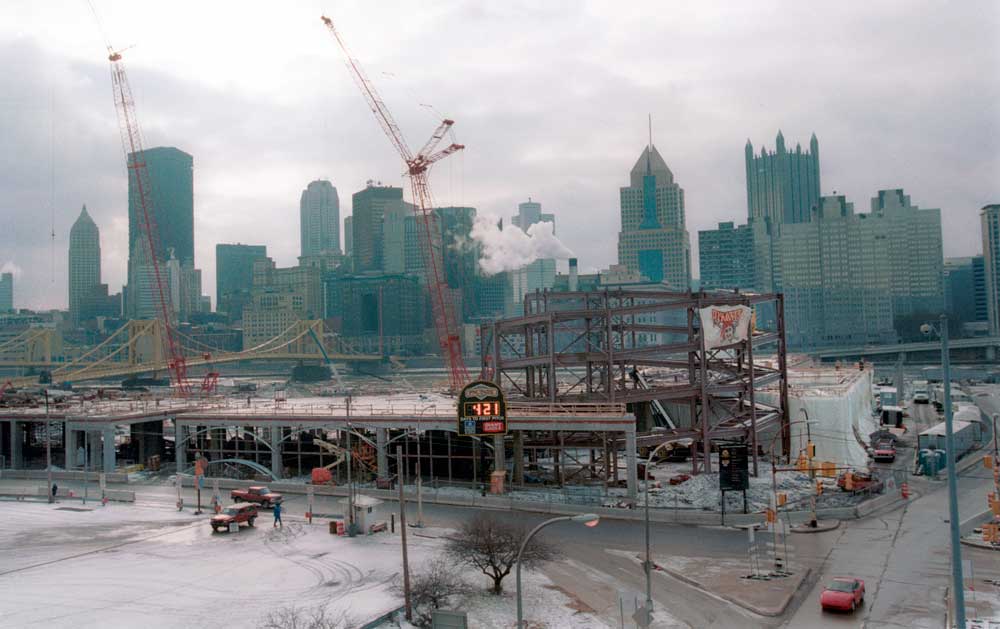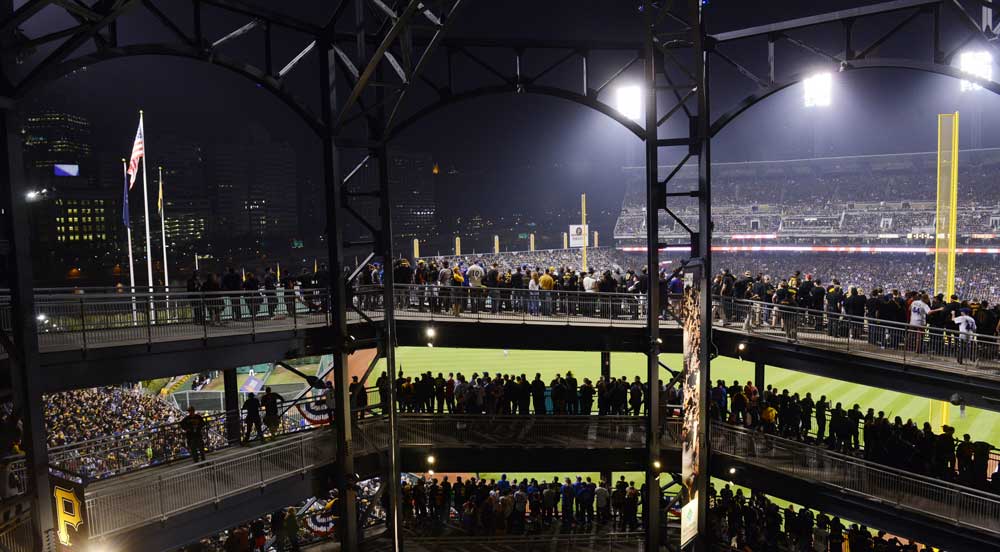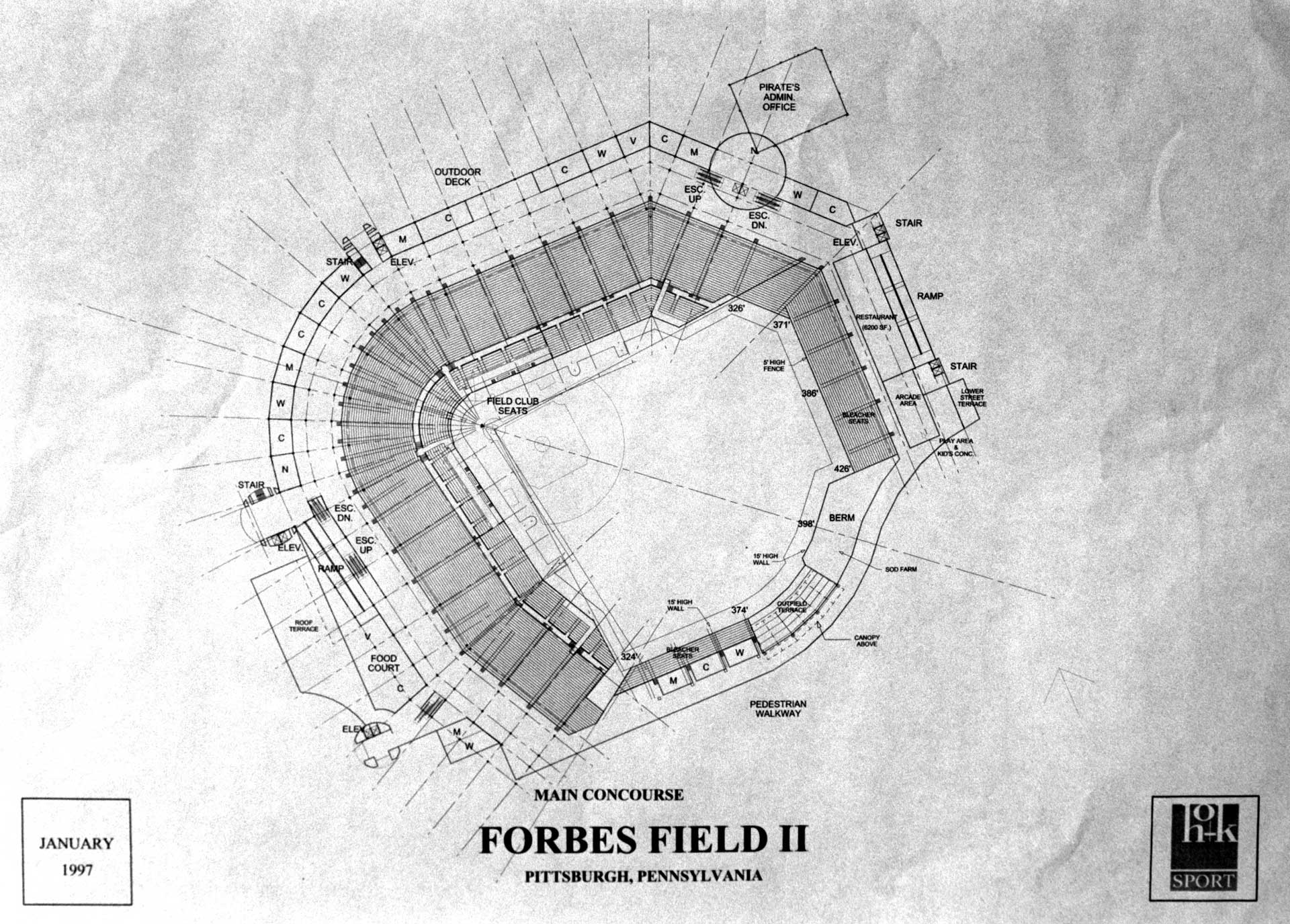PNC Park debuted 15 years ago this spring, and while that may not seem like a major-league accomplishment, consider this: When Three Rivers Stadium turned 15, it was halfway to being imploded.
The Pirates’ current home couldn’t seem further from such a dusty fate. PNC Park still is thought to be one of the best ballparks in America, even though nine stadiums have opened since the North Shore park’s first regular season game April 9, 2001.
While all three of Pittsburgh’s professional stadiums opened within a decade, PNC Park seems to soar above the rest, a symbol of the city’s rise and a source of pride for its baseball fans.
Architecture firm HOK (now called Populous), which designed PNC Park, drew upon Pittsburgh’s natural resources and manmade features, particularly in orienting the ballpark toward its signature view of the city’s skyline and bridges.
 The skeleton of PNC Park rises against the Pittsburgh skyline, Feb. 15, 2000. A sign on General Robinson Street notes there are 421 days until the new ballpark opens. (John Beale/Pittsburgh Post-Gazette)
The skeleton of PNC Park rises against the Pittsburgh skyline, Feb. 15, 2000. A sign on General Robinson Street notes there are 421 days until the new ballpark opens. (John Beale/Pittsburgh Post-Gazette)
“We learned to live in the city and understand the market,” said Earl Santee, the project’s lead architect for the Kansas City, Mo.-based firm. “We went to Primanti Bros., we went to the North Shore, we went everywhere, and we just lived that life.”
The designers also took hints from the city, particularly beloved Forbes Field, the predecessor to Three Rivers Stadium. They also envisioned the North Shore and the classic ballpark as lively extensions of Downtown via the Roberto Clemente Bridge, a fate that has borne out.
The design team’s focus on gathering spaces in and around the stadium has transformed the park and its surrounding streets into an anchor of activity on the North Shore. With two decks rather than three, PNC Park was able to maintain a feeling of intimacy, even though it is larger, in terms of square footage, than Three Rivers Stadium. Clad in cream-colored limestone and blue steel, it was the first double-decker ballpark built since 1953.
“It doesn’t overwhelm you in a way a lot of buildings can,” Santee said. “It feels familiar, but I really think it feels like Pittsburgh, 100 percent Pittsburgh.”
“When we envisioned the stadium, we also thought it should be smaller,” said Bill Newlin, chairman of Newlin Investment Co., one of the key planners for the project. “That gave the fans, particularly a baseball fan, the opportunity to get meshed with the actual field experience.”
In 2003, ESPN.com ranked PNC Park as the best stadium in Major League Baseball.
“When building a stadium, most teams just look at the most recent new one and say that they want one just like it, only bigger and more expensive,” ESPN’s Jim Caple wrote of the surprise winner. “Not Pittsburgh. The Pirates and the public built a stadium that is not only located in Pittsburgh but one that is part of Pittsburgh.
“Ray Kinsella was wrong. Baseball heaven isn’t in Iowa. It’s in Pittsburgh, along the banks of the Allegheny River.”


Left: The future site of PNC Park on the North Shore, taken February 9, 1999. (John Beale/Pittbsurgh Post-Gazette) Right: The Pittsburgh North Shore on March 9, 2016. (Darrell Sapp/Pittsburgh Post-Gazette)
But as the North Shore ballpark celebrates its quinceañera, it is worth remembering how improbable the project seemed.
“It’s like any deal that, by hindsight, seems successful and exciting. You forget the number of times the deal almost failed to get done,” Newlin said.
In 1993, the owners of the Pirates told newly elected Mayor Tom Murphy of their intent to sell the team. A clause in the contract allowed the city, which feared the team would end up elsewhere, to try to secure new, local ownership.
“When you have 113 years of tradition on your side, you can't quit. So many people have gone before -- Danny Murtaugh, Roberto Clemente, Honus Wagner and others. We had no choice. We had to succeed.”
- Kevin McClatchy, then-owner of the Pirates, discussed his efforts to keep the Pirates in Pittsburgh, which were rewarded on April 7, 1999, when construction started on the North Shore site of PNC Park.
But MLB would not permit the sale to a group led by Kevin McClatchy unless the Pirates had a new stadium — one that would not be shared with another sport, as had been true of the football-baseball mashup at Three Rivers Stadium.
The Steelers and the hotel industry argued that they, too, needed a new football stadium and convention center. So what started as an effort to keep the Pirates in Pittsburgh turned into a major redevelopment project for the region.
Fresh in Pittsburghers’ memory was the downward economic spiral of the 1970s and 1980s, when Western Pennsylvania was losing residents by the tens of thousands, businesses were getting out as fast as they could and Pittsburgh had dived face-first into double-digit unemployment.
And now, this new mayor was trying to build a new ballpark in a broke city that couldn’t pave the roads?
“To say the least, it was not popular at the time,” Murphy said.
The leaders, however, saw the ballpark as a way to turn around Pittsburgh’s fortunes, and worried about the symbolic and economic impact of the Pirates’ potential departure.
“It was a fundamental decision about whether Pittsburgh was going to continue to decline or we are going to reach forward as a city,” Murphy said.
“Do you like to ride the Jackrabbit at Kennywood? How'd you like to ride it for five years? But the roller coaster ride was worth it.”
- Pittsburgh Mayor Tom Murphy on the political battles that took place to keep the Pirates in Pittsburgh and secure financing for PNC Park at a groundbreaking event for the ballpark on April 7, 1999.
“I understood the opposition. I understood their feelings,” Newlin said. “Obviously, we felt clearly, as Mayor Murphy did, who was the major leader on this, that if you take more to the future, doing what we did was going to be a significant part of the solution, not an additional problem.”
At first, the dealmakers proposed a sales tax hike to build the stadiums, a notion voters summarily rejected in a referendum. Then local leadership, including Allegheny County commissioners Mike Dawida and Bob Cranmer, implemented Plan B, a complicated financing scheme that cobbled together several private and public funding sources for the construction, such as Regional Asset District money, state funds, money from the teams — and minimal contributions from the city.
“All the pieces had to fit together, and not everybody liked all the pieces,” Newlin said.
After two years of construction and a $262 million pricetag, PNC Park staged its first regular season game in April 2001.
Fifteen years after Murphy, Newlin and others fulfilled their promise, few Pittsburghers would argue that PNC Park wasn’t worth the effort.
“It wasn’t just about sport,” said Santee, the architect. “It was about what the city of Pittsburgh wanted to become, and it became that.”
 Fans pack the PNC Park rotunda on October 7, 2015 for the National League Wild Card Game.
Fans pack the PNC Park rotunda on October 7, 2015 for the National League Wild Card Game.
Web Design Zack Tanner
Advertisement
Advertisement

Login Register Logout